Glossary
The entries selection comes from the book “Dictionary of Judaica” (2005), which was written by a group of authors led by Eva Kosáková . Entries were further processed by Jaroslav Kuntoš, Dana Veselská, Olga Sixtová, Michaela Scheibová and Lenka Uličná. The book can be purchased at our e-shop.
Torah scroll (Heb. sefer Torah)
A scroll containing the Hebrew text of the Torah, the Five Books of Moses which are used in the synagogue during the regular reading of the individual sections of the Torah on Saturdays, Mondays, Thursdays, holidays and certain other occasions. The scroll is hand-written by a trained scribe on the basis of a model text with square Hebrew letters and without vocalization. The preparation of the materials (parchment and ink) and the actual writing of the text are subject to strict rules. The completed scroll is sewn together from several parts and is about 20 metres or more in length. In the Ashkenazi area, which includes the territory of Bohemia, Moravia and Silesia, it is wound around wooden staves with decorative handles at the end (Heb. atzei hayyim, “trees of life”) and is kept in the Holy Ark. The Torah scroll is considered a sacred object and commands special reverence. Before being placed in the Holy Ark*, the Torah scroll* (1) is always provided with the prescribed accessories. After the reading, the cylinders with the text are rolled up and tied with a Torah binder* (2). This is done as a safety measure against automatic unwinding and to prevent damage to the scroll. A decorative Torah mantle* (3) is placed over the bound scroll, which is provided with adornments. A Torah shield* (4) and Torah pointer* (5) hang on a chain over the front part. Torah finials* (6), or alternatively the Torah crown* (7), are placed on the protruding ends of the staves. The scroll is then prepared for storage.
Back to list


![[subpage-banner/2_pamatkyaexpozice_1.png]](https://c.jewishmuseum.cz/images/subpage-banner/2_pamatkyaexpozice_1.png)


![[design/2013/Twitter.png]](https://c.jewishmuseum.cz/images/design/2013/Twitter.png)
![[design/2013/Instagram.png]](https://c.jewishmuseum.cz/images/design/2013/Instagram.png)

![[homepage-banner/incident.jpeg]](https://c.jewishmuseum.cz/images/homepage-banner/incident.jpeg)